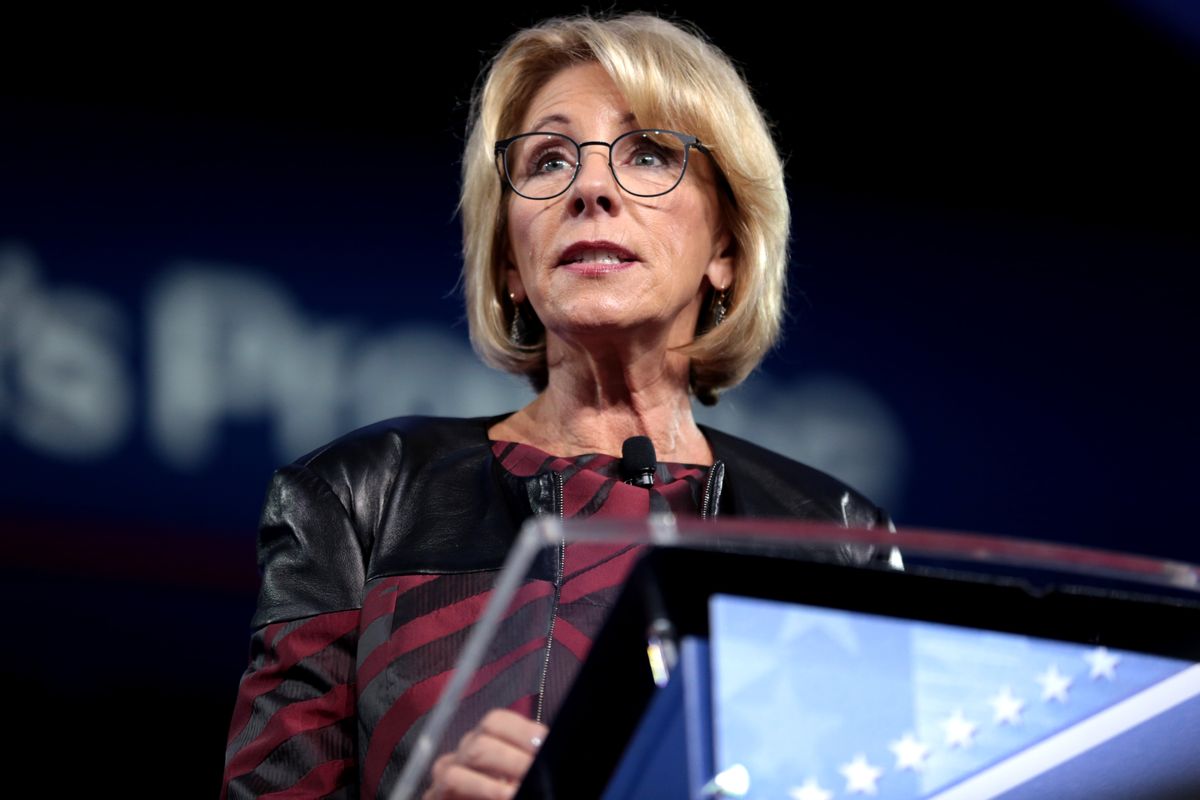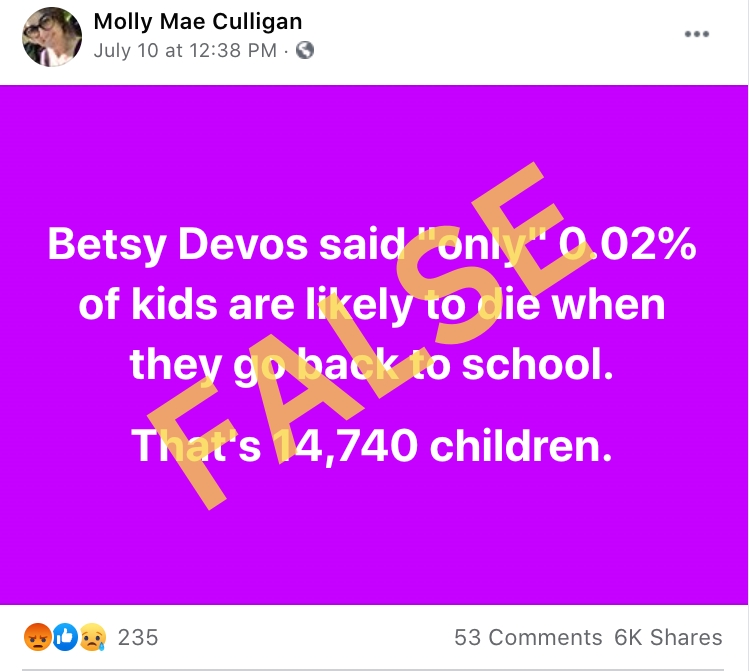In July 2020, as America's total of confirmed coronavirus cases surpassed 3.3 million, U.S. President Donald Trump criticized the advice of public health experts on how to safely reopen the country's K-12 school system during the pandemic, and campaigned in full force for in-person classes to resume nationwide.
The push by the Republican president included threats to withhold federal funding to school systems that did not agree with his approach (see the July 8, 2020, tweet here), unsubstantiated claims that state Democrats had political motivations to keep schools closed ahead of the November 2020 election, and several media appearances in which he and ally Betsy DeVos, the secretary of education, emphasized how opening K-12 classrooms would jump-start the country's distressed economy.
And during that parade of public events, critics of the country's top education official and the president claimed that DeVos had nonchalantly stated the cost of young American's lives should schools fully reopen during the pandemic. Facebook statuses and tweets went viral among educators, parents and activists, stating:
It's unclear from where, exactly, the claim originated. And first, to measure its legitimacy, we did some back-of-the-napkin math. According to the National Center for Education Statistics, the federal government prepared for 56.6 million K-12 students in fall 2019 (50.8 million in public schools and 5.8 million in private education). That means 11,320 — not 14,740 — is .02% of the country's student population.
Apart from the statement's inaccuracy, our analysis of DeVos' public appearances found no evidence to show she made the comment. We deemed several speeches at the White House, as well as televised interviews on CNN's "State of the Union" and "Fox News Sunday" on July 12, 2020, as the likely sources of inspiration for the rumor, considering the timing and content of those events. In the first of those appearances, which took place on July 7, 2020, for instance, DeVos said:
It’s clear our nation’s schools must fully reopen and fully operate this school year. Anything short of that robs students, not to mention taxpayers, of their futures — and their futures represent our nation’s future. So it’s not a question of 'if'; it’s just a question of 'how.'
The following day, after a meeting of the White House coronavirus task force, she made similar remarks, and praised several school systems for their quick transition to remote learning in the early weeks of the outbreak, including New York City's Success Academy Charter Schools and Miami-Dade County Public Schools. Simultaneously, she claimed, other local school districts were "doing next to nothing" to teach students during the unprecedented rules against in-classroom learning.
Three days later, DeVos addressed CNN's audience via an interview on why she believed schools should fully reopen in the fall, even though the country's daily spike in COVID-19 cases was on the rise and did not show signs of a decline. There, DeVos mostly re-emphasized talking points she made during the White House briefings and downplayed the health risks to students should schools fully reopen, essentially affirming the underlying sentiment to critics' claim about the projected death toll. DeVos stated, referring to "data" that she did not define:
There's nothing in the data that would suggest that kids being back in school is, is dangerous to them — in fact, it's more a matter of their health and well-being that they be back in school.
In both the CNN and Fox News interviews, DeVos pointed to research that suggests children are less likely to suffer severe symptoms due to COVID-19 compared to adults.
While people of any age with certain underlying conditions are at higher risk of serious illnesses should they catch COVID-19, children are more likely than adults to have mild illnesses, and patients over the age of 18 may have different symptoms than youth, per the Centers for Disease Control and Prevention (CDC).
According to a study of U.S. children infected with COVID-19 between February and April 2020 by the CDC, for instance, the youth population made up less than 2% of the country's cases, totaling 150,000. Additionally, three COVID-19 patients under the age of 18 died during that time frame, compared to roughly 5,450 fatal cases among adults. The study stated:
[Relatively] few children with COVID-19 are hospitalized, and fewer children than adults experience fever, cough, or shortness of breath. ... Social distancing and everyday preventive behaviors remain important for all age groups because patients with less serious illness and those without symptoms likely play an important role in disease transmission.
In other words, the CDC says: "If children meet in groups, it can put everyone at risk. Children can pass this virus onto others who have an increased risk of severe illness from COVID-19."
DeVos said school systems should consider those recommendations on a case-by-case basis, and urged local leaders to consider "granular data" that depicts COVID-19's impact on their community, specifically.
However, at no point during the broadcast interviews or the previously-mentioned White House speeches in July 2020 did the education secretary make the alleged statement about a percentage of students dying as a result of COVID-19 when schools fully reopen. Additionally, there was no evidence that she had made the statement on social media accounts, nor via press releases, around the time the claim went viral. For those reasons, we rate this claim "False."



